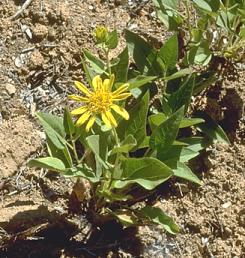| Agnorhiza reticulata | |
|---|---|
 | |
| Scientific classification | |
| Kingdom: | Plantae |
| Clade: | Tracheophytes |
| Clade: | Angiosperms |
| Clade: | Eudicots |
| Clade: | Asterids |
| Order: | Asterales |
| Family: | Asteraceae |
| Genus: | Agnorhiza |
| Species: | A. reticulata |
| Binomial name | |
| Agnorhiza reticulata | |
| Synonyms [2] | |
Wyethia reticulata Greene | |
Agnorhiza reticulata (syn. Wyethia reticulata), known by the common name El Dorado County mule's ears, is a rare species of flowering plant found only in a small region of north-central California. [3]
Contents
Agnorhiza reticulata grows in the California interior chaparral and woodlands habitats of the Sierra Nevada foothills. [1] It has been found in El Dorado, Sacramento, and Yuba Counties. [4] [3]
The genetic diversity of the populations is probably low because they are often clonal, spreading via vegetative reproduction with rhizomes rather than sexual reproduction by seed. [1] Some populations are also threatened by development of their habitat. [1] [5]
